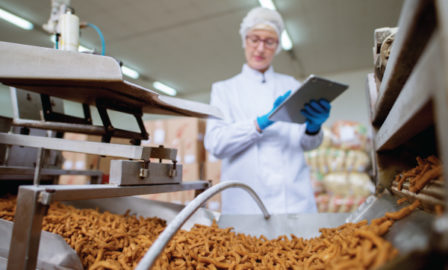HACCP in the 21st Century
Even after the introduction of HARPC (Hazard Analysis and Risk-Based Preventive Controls) under the FSMA (Food Safety Modernization Act), the HACCP model still has value to inspectors, stakeholders, and auditors. At its core, HACCP (Hazard Analysis Critical Control Point) is a set of principles that provides food and beverage manufacturers a way to brainstorm what could go wrong and how they would address such an issue. The most recent version created by the FDA added five more steps onto the original seven to create a total of 12 principles of which regulatory experts and manufacturers should be aware. Today’s digitized systems can provide a wealth of real-time, accessible data about facility conditions to help identify and prevent hazards before they occur. Facilitating these rich streams of data can improve HACCP adherence by giving regulatory experts the opportunity to ensure farm-to-fork safety.
Continued Relevancy of HACCP
While manufacturers under the jurisdiction of the FDA use the HARPC model, producers of meat, poultry, seafood, and juice inspected by the USDA still need to follow HACCP guidelines. Furthermore, all food and beverage manufacturers must follow HACCP protocol to receive annual GFSI (Global Food Safety Initiative) accreditation. The role of this type of guidance is not necessarily to prove aesthetic or nutritional quality, but to find the points in the manufacturing process most likely to introduce contamination risk to the end product.
Because the first HACCP model originated in the 1960s, the USDA has updated the guidance in order to answer more of today’s specific concerns. The model has moved beyond the traditional grouping of biological, chemical, and physical hazards to include radiological, pathogenic, and allergen contamination risks. Although consumers often worry about pesticide and antibiotic residue, microbiological pathogens usually present the most threats. E. Coli, Listeria, Salmonella, Campylobacter, and C. Botulinum represent some of the most common offenders. To reduce the risk of these foodborne illnesses, it’s critical to implement data systems that track an ingredient’s journey through the supply chain.
Overview of the Model
To create a model with lasting success, the education of manufacturing staff at all levels about food safety and HACCP principles should form part of the implementation and training curriculum. Since the original seven-step plan was created in the 1990s, it’s worthwhile to spend more time discussing the more recent five pre-step additions to the protocol.
The following pre-steps serve as the foundation of a strong HACCP program:
- Assemble the HACCP Team. Include individuals from various teams and departments to ensure the manufacturing process is understood from all angles. Consider gathering members from engineering, quality assurance, biology, and plant management. By creating a dynamic and diverse team, everyone can feel a sense of ownership over the process.
- Describe the food and its distribution. This is a general overview of the product and its shipment and processing.
- Describe the intended use and consumers of the food. Consider the product’s audience and if that segment presents any additional concerns.
- Develop a flow diagram which describes the process. This diagram doesn’t have to be overly complex provided that it covers all the processes and steps under the jurisdiction of the manufacturer.
- Verify the flow diagram. It’s suggested that the team takes the diagram onsite to check that the model is comprehensive and accurate.
The seven original steps focus on analyzing potential hazards, establishing metrics for safety, determining when and where to intervene in the process to prevent risk, and establishing monitoring and documentation procedures. A more detailed description of these seven steps can be found on the FDA’s website here.
Implementation Using Modern Technology
Integrating modern technology such as blockchain, AI, and IoT is key to optimizing your HACCP protocol. Using software for documentation can reduce errors, provide a centralized platform for S&OPs, and reduce the administrative overhead inherent in most audits. Automatic entry software increases data security because it can show when and by whom an entry was made. Smart IoT sensors provide continuous monitoring and predictive maintenance capabilities to prevent potential recalls and make equipment repairs faster. Blockchain applications can allow manufacturers to track and trace products and thereby contain the scope of a recall. Gone are the days of the “one-up and one-back” methodology. A full view of the entire supply chain from farm-to-fork empowers companies to adapt and better respond to evolving industry challenges.
Acting FDA commissioner Ned Sharpless affirmed that the path to better food safety is both “people-led” and “technology-enabled.” By combining digital technologies with a strong, detailed HACCP protocol, food and beverage manufacturers stand the best chance of adhering to agency regulations while elevating consumer trust in their products.
Subscribe to Clarkston's Insights
Coauthor and contributions by Sabrina Zirkle



